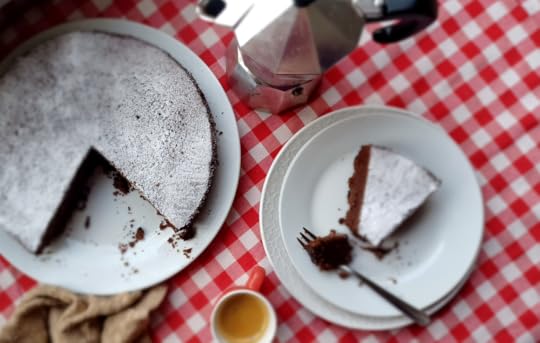Alison Ranwell's Blog, page 2
February 1, 2024
Paccheri: From 'Cucina Povera' to Michelin
Let's delve into the unusual meaning behind paccheri and their recipe for the most Michelin of sauces.

Paccheri (pah/keh/rih) truly belong to Naples. In harder times, these were a Napolitan household's go-to pasta, also known as mezze-maniche (half-sleeves) - chunky tubes in sauce or stuffed with ricotta would contentedly fill up the family. Considered part of Italy's cucina povera food culture in Naples and southern Italy, paccheri were made cheapy of semolina flour and water. It's said le mamme would typically make them on Mondays to use up the weekend's leftover ragù because whilst other types of pasta corta accompany their own sauces, these paccheri suit almost any.

The Paccheri Slap
'Paccheri' comes from the Italian for 'una pacca' - a slap. Mostly in a friendly manner, this kind of slap is an open handed one and not intended to cause injury. In Naples, a plate of paccheri plays such a part in their food culture that you can walk into your favourite trattoria and even ask for 'schiaffoni' - schiaffo is the other Italian word for slap. Don't ask for schiaffoni anywhere else in Italy though, you may not like what you get!
But why call pasta a 'slap'?
The paccheri 'slap' you'll know about when you cook with paccheri, especially when you make them (yes paccheri are plural) with one of their most traditional of sauces: sugo di pomodoro. The combination of a wide tube of pasta and a liquid sauce means the paccheri slap is 'heard' more than 'felt' both in the pan and on the plate.
Paccheri Perfected to Michelin Status
One restaurant has perfected the 'paccheri slap to such a degree that its fame has become somewhat of an institution. In fact, their customers would not be satisfied without the iconic dish mixed right beside their table and Vittorio's signature white bib supplied especially for the rather messy affair. We're not saying the humble pacchero has earned Enrico (Chicco) Cerea from Da Vittorio 3 Michelin stars but it certainly has put Bergamo's countryside restaurant in Brusaporto on the paccheri-map, enough to draw the likes of Italian celebs such as TV star Michelle Hunziker, fashionistas Chiara Ferragni and Brunello Cucinelli.
The Michelin Star sauce is none other than Naples's humble scarpariello, tweaked into the celebrated Paccheri alla Vittorio. The scarpariello, named such after the scarpari (local shoemakers who first made the sauce), sautés the region's fragrant tomatoes in garlic, chili flakes and extra-virgin olive oil until soft so that the half-done paccheri can finish cooking in the pan of sauce. Much like the mantecatura of risotto, stir in heaps of basil leaves, acqua della cottura and grated hard cheeses like parmigiano and pecorino and mix to create a deliciously creamy medley.
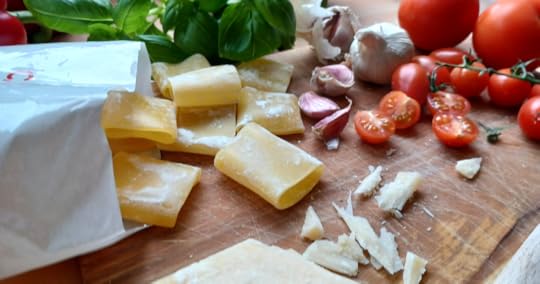
The brothers Chicco and Roberto (Bobo) Cerea from Bergamo have added butter, three kinds of tomatoes and left out the pecorino. With restaurants now in St. Moritz, Shanghai and Saigon, here's the recipe for their gloriously global Paccheri alla Vittorio and their personal cooking tips too:
Recipe for Paccheri alla Vittorio according to Da Vittorio
Ingredients:
1 Clove of Garlic
200g San Marzano Tomatoes
80g Beefsteak Tomatoes
50g Baby Plum Tomatoes
20g Butter
70g Grated Parmigiano Reggiano
10 Fresh Basil Leaves
Extra-Virgin Olive Oil
Salt and Pepper
Optional: Dried Chili Flakes
Method:
In a wide and deep pan, saute the garlic in half a cup of good olive oil. Add the three types of tomatoes which have been chopped into small pieces.
Add the salt and pepper and cook on a low heat for 35-40 minutes until soft.
Blend the sauce with an immersion blender or in a food processor and strain through a sieve (if needed) to obtain a smooth consistency. Return the sauce to the pan.
Cook the paccheri according to their packet instructions until al dente.
Strain them keeping a cup of acqua della cottura aside and add the paccheri directly to the sauce in the pan on a low heat.
With a wooden spoon, mix the butter and grated cheese into the sauce and keep stirring until smooth. Add l'acqua della cottura if needed, the roughly-chopped basil leaves, a drizzle of olive oil plus the chilli flakes and stir for another few minutes. Serve hot!
Cooking Tips
Use the ripest tomatoes you can find for the sweetest flavour. Piccadilly work well if you can't find San Marzano.
Use Parmigiano Reggiano that is 22 months matured or less for creamy texture.
Mix continuously whilst adding the cheeses until a smooth sauce is obtained - this is easier if one person sprinkles cheese and the other mixes. You can add more acqua della cottura to make it silky.
Buon appetito my friends!
Allora , did you hear the slap?
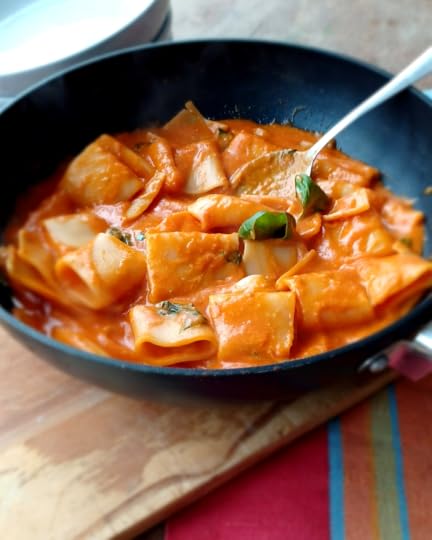
In his interview from 2019, Chicco Cerea says one shouldn't chase Michelin stars; if you cook with love and the passion of your trade then keep doing what you're doing and the third star will naturally come.
Let's toast to that!
Here's to simple being best
and cin cin to a love of cooking.
Salute!
Find the recipe for our Paccheri allo Scarpariello in our new cookbook Appetito❤️
January 25, 2024
Trevi Fountain: The Real Reason You Should Toss a Coin
On busy days, Rome's Trevi Fountain attracts over one thousand visitors an hour, that's four thousand people a month and 5.4 million a year.
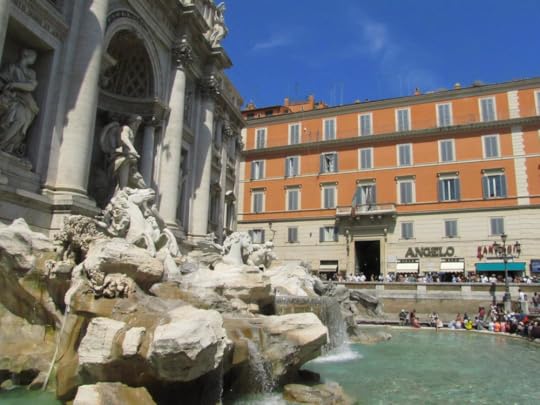
A resplendent sculpture at an ancient water source, the name Trevi stems from 'Tre Vie' - three streets. In ancient Rome, the convergence of three important city roads happened where water was brought from the aqueduct Acqua Virgo built in 19 BCE. This spot has always been sacred; legend says pure water bubbled from the earth where a beautiful virgin led soldiers to drink. These waters supplied Rome's multitude of fountains and baths, the aqueduct was named after her. Commissioned by Pope Clement XII in 1732, Roman architect Nicola Salvi fashioned a lavish design in Travertine stone, the same used for the Colosseum, before dying 19 years later. His masterpiece was to be completed by Pietro Bracci, a local sculptor, who finished the fountain in 1762, it has since become one of Rome's most iconic of attractions.
Boosted to stardom in Fellini's La Dolce Vita, Sylvia (Anita Ekberg) climbs into the pool and beckons Marcello to join her while she stands beneath the cascading water in a sultry scene. Marcello does join her but the film that created Trevi's ritual of tossing a coin was in fact "Three Coins in the Fountain" from 1954, where one coin signified a return trip to Rome, two meant love and three meant marriage.
Ever since 1954, a visit to Rome's gorgeous Trevi Fountain isn't complete without the tradition coin toss.
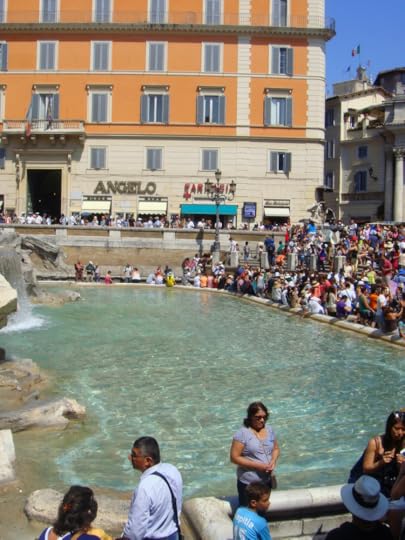
How to Toss a Coin into the Trevi Fountain
For the magic to work, you must stand with your back to the fountain and toss a coin with your right hand over your left shoulder but this does become tricky when Trevi's smooth, white steps are packed with people. There's an unseen system of visitors who wait their turn to get to the water's edge which is not always easy and does take time, especially on Rome's busiest of days. However if you're after love, travel and a spouse, then it might be worth the wait and the spare change of course.
Millions of Coins in the Fountain
With 5.4 million visitors a year, you can imagine how many lucky coins touch the Travertine fountain floor every day, so where do they all go?
Each morning at dawn, the fountain is vacuumed and the treasures all sucked up. Thousands of coins and other oddities (like watches and even dentures) are taken to an office to be cleaned and divided into currencies amounting to a whopping €3,000 a day!
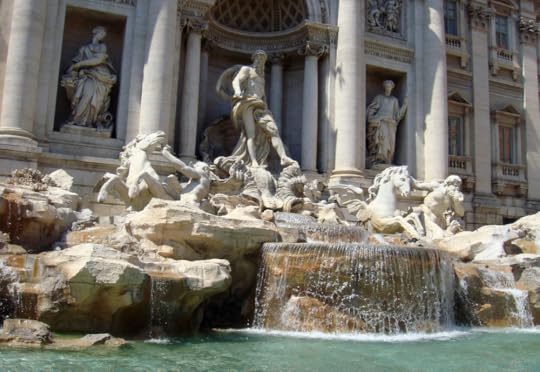
The Real Reason You Should Always Toss a Coin is not one of desire, love or luck, it is one of charity. Since 2001, Caritas Roma converts every lucky token into someone's lucky day. One of the most effective of Catholic charities is a group of supermarkets for the needy. Five Empori della Solidarietà (Emporiums of Solidarity) around Rome provide ingredients and supplies at zero cost to over 2000 families who can apply for a card through Caritas Roma to do their household shopping gratis. In 2022, Caritas Roma collected 33 thousand kilograms of coins from the Trevi Fountain which meant €1.432.953,74 of funds could be distributed between their charities including soup kitchens providing 53 thousand meals to the hungry in one year. "It's not only food," says Director Giustino Trincia, "In 2022,we helped 70 unemployed citizens find jobs and helped others pay their bills. We fund support centres for children under 3 years old before starting school and others for teens with built-in language schools for foreigners.'

So next time you're in Rome, go feast your eyes upon sublime sea creatures and marine god Oceanus, his chariot of sea horses and the beautiful virgin of the aqueduct. There's Abundance, Wealth, Fruits and Crops, water spouting and beauty abounding in a spectacle which we think is glorious lit up by night. Grab a gelato (here's our guide) and find a spot on the stone steps to marvel at one of Rome's most decadent of sights. Take a while to note the detail, dip your fingers in the water (but not your toes) and dig deep into your pockets to take part in a tradition which is bound to bring luck, maybe not to you but certainly to someone.
Toss one coin, two or go on, toss four...
Buona Roma amici.

For our guide on the best place to stay in Rome and the best time of year to visit, click here and if you haven't already, subscribe for weekly snippets of Italy dropped into your inbox every Friday morning - unique destinations, travel tips and regional recipes - perfect breakfast reading, The Italian Way.
January 18, 2024
Torta Caprese - The Delectable Cake of Capri
Capri is a little isle with a big heritage. Temples, grottos, kings and queens - you may be reminded of the famous salad but there's also a famous cake.
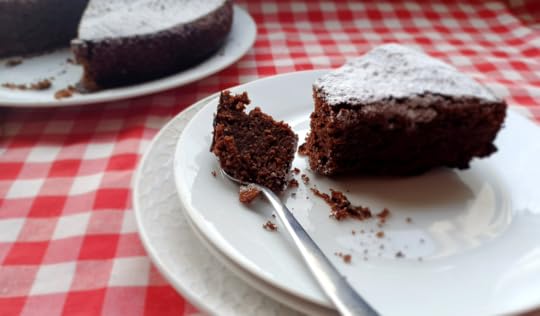
Just off the coast of Sorrento, the island's rugged outline appears over hazy seas, seen from the Amalfi Coast as a distant paradise beckoning you closer. Home to the most alluring of temptresses, the Sirens, Capri has drawn glitz, glamour and fame since the ancient Greeks constructed an acropolis here in the 8th Century BCE. Emperor Tiberius adored the place so much he built the grand Villa Jovis (Villa of Jupiter) as a holiday home, and who can blame him? If the crystalline waters and jagged cliffs don't tempt you enough, then the balmy Mediterranean lifestyle; lounging on terracotta terraces of lemon trees, dining on some of Italy's most gorgeous foods and sipping the crispest white wines most certainly will...
In Naples, you'll spot the beloved Torta Caprese on many dolci menus. The cake of Capri.
Don't be swayed by its simple attire, this cake is beautifully decadent, just like Capri, it's also flourless.
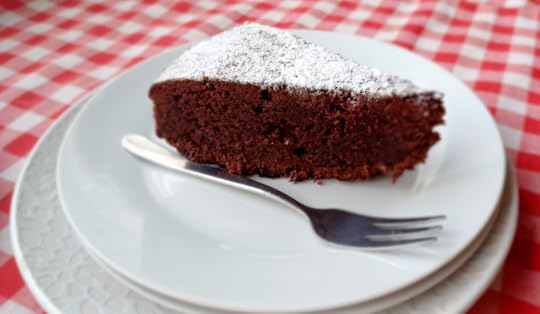
The Legend
No prized Italian product is without its romantically-enthralling legend. Much like the love-struck cheesemaker who left his curds out overnight and created Gorgonzola, Capri's legendary cake owes its fortuitous creation to error.
In 1920, the well-known, local pastry chef, Carmine di Fiore somehow slipped up and left the flour out of his chocolate and almond cake. Perhaps he was distracted by the island's sparkling waters through his bakery window, perhaps after a long pausa pranzo, he sat dozing in the sunshine and woke up flustered, some Capri residents say he was under such pressure to bake for the legendary gangster Al Capone he messed up - it happens... Nevertheless, what resulted was a dense, chocolatey cake with a crunchy crust, much like a grainy brownie. This dessert is such a delight for the senses, that traditionally only a simple dusting of icing sugar is sprinkled on top because truly, it can stand on its own as a gorgeous slice of Capri confectionery.

Torta Caprese Ingredients
Almonds are a popular regional ingredient around Naples, Sicily and the Amalfi Coast. Here, they are often ground into flour and used in cakes, naturally as a gluten-free alternative but mainly as a prized local speciality. Pesto Pantesco is made from almonds....
If you can find skinless almonds, it's easy to make flour in a food processor. Otherwise, ground almonds, almond flour or almond meal (in the US) can be used.
Dark Chocolate must be good quality and at least 70% as the most important flavour of Torta Caprese.
Italian butter is never salted so add a pinch of salt to balance the flavours if you're making it in Italy.
Eggs should always be at room temperature for the fluffiest results and the only remaining ingredient is sugar. Traditionally, Italians use plain white sugar in baking, however to create a spongier texture, castor sugar is the better option here.
Recipe Tips
Because this cake has no gluten (from wheat flour) to hold the air bubbles and create a sponge, it's fundamental that your egg whites are beaten until stiff and folded in very delicately.
A trick is to first beat the egg whites and then add half the sugar whilst beating at a slower speed until it is incorporated. This gives the egg whites a little more structure and helps prevent them from collapsing.
Potato starch is often used in Italian baking and can easily be found in shops and supermarkets. Some Torta Caprese recipes call for fecola di patate but the original recipe is incredible simple and only consists of five ingredients.
Oranges and lemons grow so happily in this balmy Mediterranean climate that everyone loves them in their cooking. Torta Caprese has been known to include a squeeze of fresh orange or a grate of the rind as a traditional option.
Another option is a splash of Gran Marnier or Rum in the batter!
And finally, Torta Caprese is traditionally served upside-down in Capri! Let the cake cool completely before turning it out to avoid any breakage and then, depending on the shape of your cake pan, why not do it the Capri-way? With a dusting of icing sugar and basta..
Find the full recipe in our new cookbook Appetito❤️
A presto amici!
